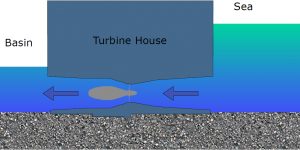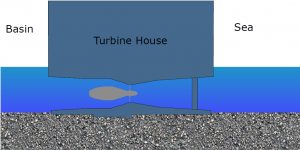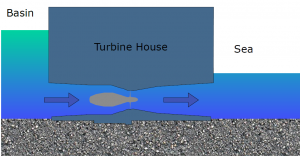A tidal lagoon is a power station that generates electricity from the natural rise and fall of the tides. Tidal lagoons work in a similar way to tidal barrages by capturing a large volume of water behind a man-made structure which is then released to drive turbines and generate electricity. Unlike a barrage, where the structure spans an entire river estuary in a straight line, a tidal lagoon encloses an area of coastline with a high tidal range behind a breakwater, with a footprint carefully designed for the local environment.
As the tide comes in (floods) the water is held back by the turbine wicket gates, which are used to control flow through the turbine and can be completely closed to stop water entering the lagoon. This creates a difference in water level height (head) between the inside of the lagoon and the sea. Once the difference between water levels is optimised, the wicket gates are opened and water rushes into the lagoon through the bulb turbines mounted inside concrete turbine housings in a section of the breakwater wall. As the water turns the turbines, electricity is generated.
The water in the lagoon then returns to closely match the same level as the sea outside. This process also happens in reverse as the tide flows out (ebbs) because the turbines are ‘bi-directional’ and so electricity can be generated from the incoming and outgoing tides. We can hold the tide within the lagoon for approximately 2.5 hours as the sea outside ebbs and the head builds.
As the tides rise and fall naturally, with no requirement for fuel, tidal power is truly renewable and, unlike other forms of renewable energy, is entirely predictable. As there are always two high and two low tides every day, tidal lagoons will generate electricity over four periods a day, every day of the year. As we hold the tides for 2.5 hours four times a day, we can generate power for up to 14 in every 24 hours. The height and time of the tides can be predicted years in advance to a high degree of accuracy, allowing the precise operation of the lagoon on each tidal cycle to be optimised well in advance.

Generating on the flood tide

Holding period at high or low water

Generating on the ebb tide
